Many researchers get confused about what can or cannot be labeled as editing. There are still people who tend to confuse proofreading with editing as the same thing. However, that is not the case. Proofreading is a type of editing and falls under the process of writing. In this article, we will take the liberty to go through some of the most basic and most important types of editing that you must know of.

Many researchers and students get confused about what can or cannot be labeled as editing. There are still people who tend to confuse proofreading with editing as the same thing. However, that is not the case. Proofreading is a type of editing and falls under the process of writing. If you are an individual who belongs to the literary field or is preparing to enter it, you should know this very basic yet important factor. In this article, we will take the liberty to go through some of the most basic and most important types of editing that you must know of.
Editing is an elaborate step in the process of writing that involves going through the piece of writing over and over again to ensure that it is perfect. Editing involves simple steps such as looking for minor and major grammatical, spelling, and punctuation errors. It also involves more complex checking, such as looking for structural issues, style of the writing, consistency of format, the relevance of content, and more.
What editing essentially does is make your writing better to ensure that your readers get the message you are trying to convey clearly. Also, it aims to bring the best out of your writing to ensure that it reaches its true potential.
To think that editing is one simple process is a big mistake. Instead, editing is a layered process that involves further sub-processes. It may need double, triple, and sometimes even multiple rechecks to approve the work.
Therefore, it only makes sense that there are different types of editing and that there are different individuals who specialize in these different types. Next, we will take a close look at what these different types of editing are and where they are generally used.
Structural editing ensures that your work is structured properly, so there is a good flow and style to your writing. These types of editing are considered major editing that aims to ensure that the overall quality of your work is improved. Here, editors look for the structure of your sentences, paragraphs, the flow of the content, and so on.
Line editing, as the name suggests, is the type of editing that occurs line by line. In other words, your editor goes through your work line after line, making sure of the following factors:
Choice of words
Writing impact
Clarity
Simplification of your work
Copy editing is close to line editing and is performed at the end of the process, usually before proofreading, which is the last step of the writing process. Copy editors ensure that your work is of the highest quality by keeping their focus solely on grammatical errors, choices of words, citation and reference errors, etc. They will also make sure that the style and tone of your work are consistent throughout the manuscript.
As you notice, the main difference between copyediting and line editing is that copyediting should always be done after line editing, never at the same time. Thus, copyediting is considered the last task before the manuscript goes into publication. A regular editor or line editor should check errors in grammar, punctuation, syntax, and spelling in a manuscript before copyediting.
As the anime suggests, content or developmental editing focuses most on the content of the work. It is also considered one of the first stages of the editing process. Here, the editor will focus on the logical flow of the content, its relevance, how developed the content is, and so on. In this stage of editing, the editor may ask you to make substantial changes to your writing where they may suggest adding or removing a considerable amount of the text. They may ask you for more explanation or information or suggest you remove part of it.
However, it is completely up to you whether you decide to heed their advice or not. After all, it is your work and idea that you want your readers to read.
Lastly, the editing process wraps up with proofreading as its last step. In academic editing, proofreading is one of the most commonly misunderstood terms, as people believe editing and proofreading to be the same thing. However, that is not the case.
In proofreading, the proofreader goes through your text one last time to ensure that it is perfect for publication or submission. A proofreader looks for typos, minor spelling mistakes, grammatical and punctuation errors, citation errors, and so on. This stage does not require big changes, but if the proofreader notices such complications, they will send in a request for re-edit.
Proofreading aims to correct all errors in grammar, punctuation, syntax, and spelling in a manuscript. If you wish to see whether the final version of your document contains any minor errors, then you need proofreading services instead of editing services.
Editing necessitates more of an extra effort from an editor than does proofreading. Our editing service will improve the academic quality of your manuscript, hence the content, overall structure, quality of findings and analysis, simplicity, and referencing.
Editing will mostly make some fundamental changes to improve the standard of the academic writing of the document. Accordingly, editors will sometimes re-write some parts of your document. This is especially important because an editing service aims to guarantee that the purposes of the document are met.
An editing service ensures that a paper is error-free. Thus, an editor will correct all errors in grammar, typography, punctuation, syntax, and spelling in a manuscript. In this sense, the editing service includes a proofreading service as well. However, strictly speaking, proofreading your document is the last stage before it is delivered to you.
Therefore, even if an editor has corrected many of the errors that a proofreader would correct, the document must still pass through this last stage—proofreading.
So, that is all there is to know about the different types of editing. All these types of editing together make up the editing process. However, it is not always necessary for you to go through all the stages. Depending on your needs, you may need only one or a few types of editing. You can approach a professional service provider for advice on the kind of editing that you may need.
Best Edit & Proof expert editors and proofreaders focus on offering manuscripts with proper tone, content, and style of academic writing, and also provide an upscale editing and proofreading service for you. If you consider our pieces of advice, you will witness a notable increase in the chance for your research manuscript to be accepted by the publishers. We work together as an academic writing style guide by bestowing subject-area editing and proofreading around several categorized writing styles. With the group of our expert editors, you will always find us all set to help you identify the tone and style that your manuscript needs to get a nod from the publishers.

You can also avail of our assistance if you are looking for editors who can format your manuscript, or just check on the particular styles for the formatting task as per the guidelines provided to you, e.g., APA, MLA, or Chicago/Turabian styles. Best Edit & Proof editors and proofreaders provide all sorts of academic writing help, including editing and proofreading services, using our user-friendly website, and a streamlined ordering process.
Visit our order page if you want our subject-area editors or language experts to work on your manuscript to improve its tone and style and give it a perfect academic tone and style through proper editing and proofreading. The process of submitting a paper is very easy and quick. Click here to find out how it works.
Our pricing is based on the type of service you avail of here, be it editing or proofreading. We charge on the basis of the word count of your manuscript that you submit for editing and proofreading and the turnaround time it takes to get it done. If you want to get an instant price quote for your project, copy and paste your document or enter your word count into our pricing calculator.
Contact us to get support with academic editing and proofreading. We have a 24/7 active live chat mode to offer you direct support along with qualified editors to refine and furbish your manuscript.
Follow us on Twitter, LinkedIn, Facebook, Instagram, and Medium.
For more posts, click here.
This article discusses four common types of editing in academic writing. To give you an opportunity to practice proofreading, we have left a few spelling, punctuation, or grammatical errors in the text. See if you can spot them! If you spot the errors correctly, you will be entitled to a 10% discount.

The difference between proofreading and editing is a challenging issue to understand. This article explains the main differences between these two concepts. The blog provides a general overview of these two concepts and discusses what they comprise. Knowing the difference is especially important when you intend to hire an editor to polish up your manuscript.
Continue Reading
Most researchers do not fully comprehend the main difference between line editing and copyediting. Although there are some similarities between these two services (e.g., both take full note of the use of a manuscript’s language and involve improvements of the content, overall structure, and quality of the manuscript), there are still important differences between them.
Continue Reading
No matter what anyone suggests, you should always get your work edited and proofread. That is a rule that you, as a writer, should always abide by. However, how do you choose the right editing and proofreading services? If you were to go online and search for such services, you would easily come across a dozen such service providers. But how do you recognize which one is right for your needs and which one is reliable? In this article, we will address that question and discuss a few factors that will help you choose the right editing and proofreading services.
Continue Reading